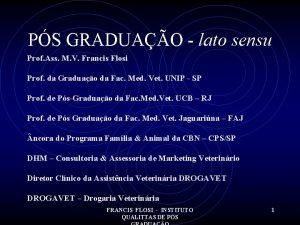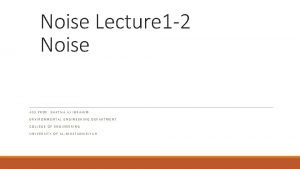Noise Lecture 1 Noise ASS PROF SHATHA AJ





- Slides: 5

Noise Lecture 1 Noise ASS. PROF. SHATHA AJ IBRAHIM ENVIRONMENTAL ENGINEERING DEPARTMENT COLLEGE OF ENGINEERING UNIVERSITY OF AL-MUSTANSIRIYAH

1. 1 Noise can be defined as unwanted sound or sound in the wrong place at the rong time. Noise is undesirable because it interferes with speech and hearing, is ntense enough to damage hearing or is otherwise annoying. The definition of noise as unwanted sound implies that it has an adverse effect n human beings and their environment, including land structures and domestic nimals. it is also disturbs natural wildlife and ecological systems.

. 2 Sound Wave Sound is a mechanical energy from a vibrating surface which spreads as pherical or plane wave forms and is transmitted by a cyclic series of ompressions are rarefactions of the sound transmitting media. The sound results n a sound pressure longitudinal wave that alternatively rises to a maximum evel. Waves may be of two sorts, transverse and longitudinal. While solids will ransmit both kinds, liquids and gases will transmit only longitudinal waves. ound waves are usually shown as if they were for instance on an oscilloscope (transverse ompression) and drops to a minimum level (rarefaction). On striking the ear, it ay be heard as sound waves. Sound pressure variation of a sine wave showing the phase relationship between ressure and particle displacement. Amplitude (A) : the maximum or minimum pressure.


Period (T) : the time lapse between successive peaks. Frequency (f) : the number of complete pressure variations or ycles/second. Relationship: T=1/f λ=c/f Based on energy transmittance characteristics they are categorized as lectromagnetic and mechanical waves. An electromagnetic wave is a ave, which is capable of transmitting its energy through a vacuum hereas a mechanical wave is not capable of transmitting its energy hrough a vacuum. The speed of propagation (c) of sound in air is 340 m/s, at 20 o. C and 1 tmosphere pressure. At other temperatures, it may be calculated by sing the formula: C=20. 05√(273+temp. ) Sound / noise results from periodic disturbances of the air at room emperature are propagated in air at a speed of approximately 340 m/s. n water (1500 m/s) and steel (5000 m/s), the speed is much greater.









